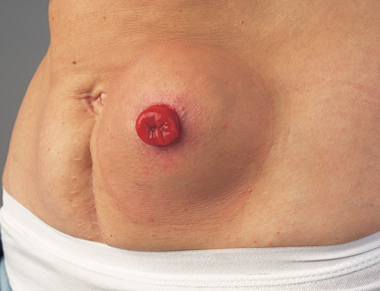By Robin Glover
No need to be alarmed, but if you have an ostomy you already have a hernia! When the surgeon opened your abdominal muscles to pull your intestine through, they technically gave you a hernia. But we’re not talking about that kind of hernia. We’re talking about parastomal (peristomal) hernias. That’s when more intestine than planned pushes through your muscles and causes a bulge at your ostomy site.
You can tell if you might have a parastomal hernia by a noticeable bulge or by placing your hand over your stoma and seeing if it protrudes out when you cough. (This doesn’t count as an official diagnosis. You’ll probably also want to talk to your doctor.)
What Is a Parastomal Hernia?
A parastomal hernia is like any other hernia. They happen when an organ pushes through a weak spot in the muscle. For people with an ostomy, the organ is your intestine and the weak spot is in the same area the surgeon created your stoma.
intestine and the weak spot is in the same area the surgeon created your stoma.
While every effort is made to close everything and ensure a tight, snug fit, some extra intestine can force its way through and push against your skin. (This is as opposed to a prolapsed stoma when extra intestine is actually coming out of your body.)
Parastomal hernias usually happen within the first one to two years after ostomy surgery, but can occur later. While people without a parastomal hernia will tell you they’re mostly asymptomatic, those with one will likely beg to differ. Parastomal hernias can cause discomfort and pain and make it difficult to keep your appliance on.
Dealing With a Parastomal Hernia
One of the most frustrating things about having a parastomal hernia is dealing with leaks. Every parastomal hernia is unique and they come in all shapes and sizes so finding the right pouching system is important. It can take some experimenting and ordering plenty of free samples from ostomy supply companies to get it figured out.
If possible, you should also consult with a Wound Ostomy Care nurse. In fact, you should probably do this first. It can save you plenty of time and frustration. Check out this link for resources on finding one. Ostomy nurses are out there and ready to help!
Preventing a Parastomal Hernia
The best way to prevent a parastomal hernia is to listen to your doctor. When they say to not lift anything over 10 pounds for 4-6 weeks after surgery, don’t do it! You should also always be careful about what you lift and use proper form no matter how long ago your surgery was. It’s also a good idea to wear an ostomy support belt or undergarment when you’re working out or doing any strenuous activity, and to apply pressure to your stoma when you cough or sneeze.
Strengthening the area around your stoma site can help, too. But, as always, check with your doctor before beginning any sort of exercise routine. (Also, as always again, quitting smoking and/or maintaining a healthy weight can make a big difference.)
How Do You Fix a Parastomal Hernia?
Well, there’s no simple answer. Like every parastomal hernia is different, so are our bodies and the surgeries we’ve had. It will take consulting with your doctor or a WOC nurse to find a plan of action that’s specific to your needs.
But something you can do right now is find support from the ostomy community. We are a tight-knit group (and just not our sutures!) of people always eager to help and offer a listening ear.
Robin Glover is a writer based in the Houston area. He has a permanent ostomy after being diagnosed with Crohn’s Disease in 2017.



